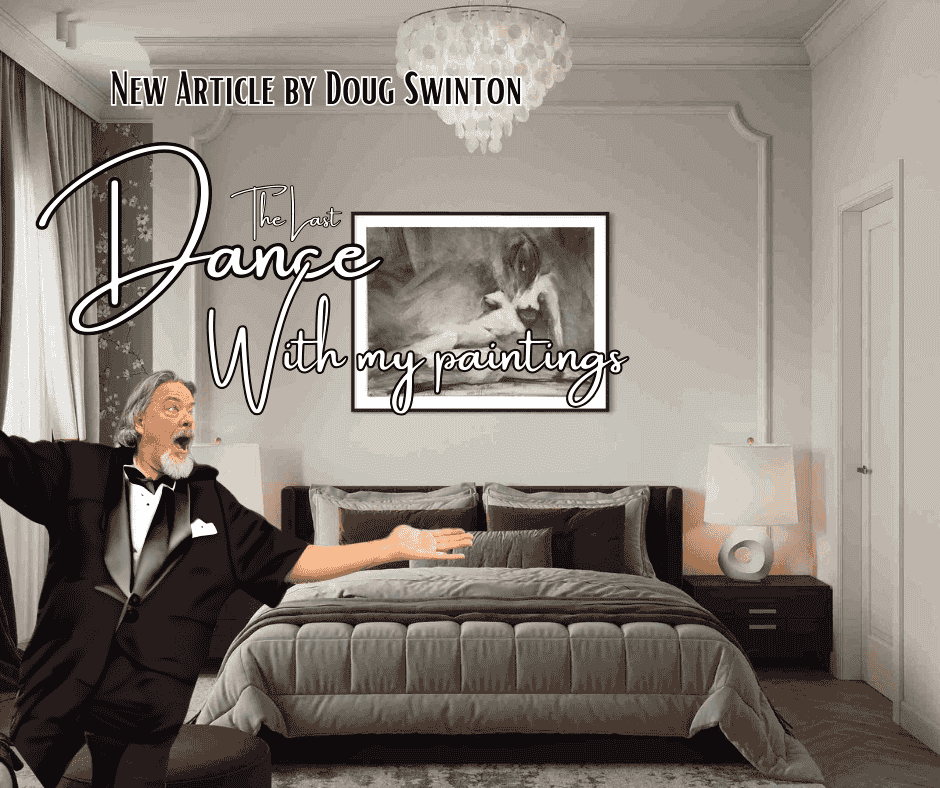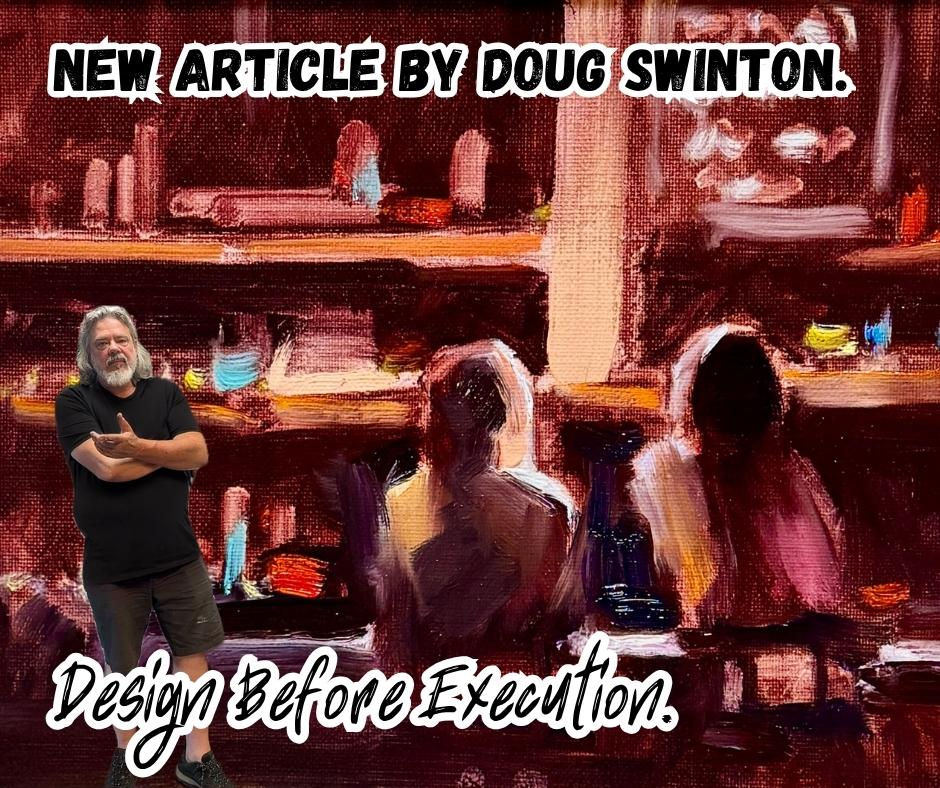5 ways to improve yourself and your art.
- Doug Swinton

- Apr 9, 2020
- 5 min read
Updated: Mar 15, 2021
Take charge of your art.

It's not all about education, but some knowledge can help. You need a vision and it is difficult to visualize without having some sort of foundation. To know what is possible is very helpful in order to decide on the path to take. Once you know the path, practice will get you there.
This is an article about the importance of learning from other artists, about the value of practice, about letting go of expectations and about living on the edge.
Sprinkle in some Japanese proverbs and you have a formula for a successful art practice and a peaceful life. :)
Now let's chop some wood...
1. By The Book
”Self-taught”… I frequently hear proclaimed, but is there ever really such a thing as self-taught? Self-taught is like the blind leading the blind! Self-direction might be a better tune to sing.
We all need instruction, inspiration and a bit of indoctrination. The best thing you can do to improve your art is to go to museums, read art books and to get some top-notch instruction.
Instruction comes in two forms, both of which are critical for getting ahead in a different way: Regular instruction (art classes) and workshops.
Regular instruction means weekly lessons that guide you along towards your vision, with the assistance of an experienced instructor to help you identify weaknesses and bolster your strengths. Practice is key for improvement and weekly instruction certainly helps.
Another point to consider is that home distractions and lack of a good workspace, all point to the need to get out and take art classes on a regular basis. Weekly instruction keeps you focused, sharp and ahead of the learning curve.
Workshops are a different ball game. They offer different insights, often specific to a technique or style. Workshops can open your eyes to an approach you never considered and open up new directions to explore. They are a short but intense way to gain knowledge.
I’ve been painting for many many many years and I still take workshops, and always walk away with something to implement in my regular practice.
Things to keep in mind…
For regular instruction
Choose a teacher whose art you admire. Look at their paintings and see what it is you like and what you want to learn from them. Choose classes that are small, informal, with the right equipment and surroundings. Opt for an instructor that offers personal time and plenty of one-on-one as well as group instruction.
For workshops
Know what you are taking with purpose. Before you sign up for a workshop know what it is you want to learn. Keep your focus. The instructor may show you an overwhelming amount of things, so keep focused on what it is you came for. You can’t absorb it all! I always say - If you learn three new things in a workshop that you can utilize, you’ve had a successful workshop. Then, for the next while, practice those things until you have mastered them.
NOTE: I recommend that you take no more than two workshops a year. Any more than that and you will start to confuse yourself and your work.
“Better than a thousand days of diligent study is one day with a great teacher.”Japanese proverb"
2. The Art of Practise
“Two Texan’s on their way to a concert in New York city stop the car and ask a stranger on the street. “How do you get to Carnegie Hall?” “ Lots of practice!” was the answer.
Practise painting regularly even if you seem to be getting nowhere. This might seem onerous but you will reap the benefits in good time. Soon, practice will become part of your routine and it will be helpful for you during a time of struggle. Try executing a 20-minute painting every day and see what happens.
“Practise is the path upon which you travel.” Japanese proverb
3. Wave the White Flag
Surrender. To learn new things one must surrender the old ways. “Old habits die hard.”
For some, this may be the hardest thing to achieve. Surrender means letting go of all you know - all the familiar ways and expectations. Allow yourself to be an empty vessel and make room for new knowledge, new approaches and fresh ideas.
Nothing is more important than surrender when taking a workshop. You must be willing to fail. Face the fear and don’t be afraid to look like a beginner.
The famous rock drummer Neil Peart (RIP) from the Canadian band Rush, was considered Rocks greatest drummers. After 30 years of playing, he felt he was getting a bit rusty, predictable and formulaic, so he sought out legendary drumming instructor Freddy Gruber. The first thing Freddy made Neil do was to hold his drum sticks differently. After a few lessons, Neil asked Freddy why he was making him hold his sticks differently. Freddy replied “So you can’t play the way you play and I can teach you something.”
“The courage of a master is measured by his or her willingness to let go.” Japanese proverb.
4. I can see clearly now the rain is gone.
Intentionality. Know where you’re going before you go.
“Never make a shot till you visualize where it’s going to go.” Jack Nicholas
Jack Nicholas and his $1 golf book. Read my article HERE.
Jack envisions every shot landing on the green before he shoots. He says that golf is 50% visualization, 40% set up and 10% swing. I believe this. Painting is 50% visualization (picking the right thing to paint) 40% set up (having the correct equipment, surface and paints) and 10% painting (the act of painting).
This is why some paintings can look almost chaotic in application yet resonate as a beautiful work of art. Don’t kid yourself, you still need to learn all the aspects of the craft of painting but the application of paint doesn’t matter as much as having the vision.Vision matters the most.
Visualizing a scene or a photograph as a finished painting will take you a long way to finishing a painting successfully. It is useful to have a general idea of your destination. Visualize the path your painting will take and imagine what you want the final piece to look like. Practise this simple trick and soon you will find yourself inside your mind’s eye. Your inner vision can take your paintings to places you want it to go. Thoughts, images and feelings are real because you act upon them.
“Vision without action is a daydream. Action without vision is a nightmare.”Japanese proverb.
5. If you’re not living on the edge you are taking up too much real estate.
Work the edge. One must walk the edge between endless practice and exploring new territories.
Buddha said - ‘Before you learn the deeper meaning; chop wood, carry water. Once you attain enlightenment; chop wood, carry water.’
You need to push yourself beyond your safe limits, to the edge of the unknown. Go places you have not been before, out of your comfort zone. That little voice inside is screaming at you to follow a new direction. Learn to listen to it.
To get to the edge you must practice. ‘Chop wood, carry water.’ When the edge appears, the challenge is accepted. Once you master the edge, it again becomes “chop wood, carry water.” Practise and crawl to the edge once again. It’s a wonderful never-ending path.
“If you don’t enter the tiger’s cave, you can’t catch its cub”. Japanese saying.
Learn to work with these 5 concepts and the art world will not just be your oyster, it will be an oyster in wine and garlic butter sauce…..mmmmm
Happy endless challenges!
Your friend in art,
Doug.








monero miners monero miners
monero miners monero miners
monero miners monero miners
monero miners monero miners
monero miners monero miners
monero miners monero miners
etc mining etc mining
monero miners monero miners
monero miners monero miners
monero miners monero miners
monero miners monero miners
monero miners monero miners
monero miners monero miners
etc mining etc mining
monero miners monero miners
monero miners monero miners
monero miners monero miners
monero miners monero miners
monero miners monero miners
monero miners monero miners
etc mining etc mining
monero miners monero miners
monero miners monero miners
monero miners monero miners
monero miners monero miners
monero miners monero miners
monero miners monero miners
etc mining etc mining
monero miners monero miners
monero miners monero miners
monero miners monero miners
monero miners monero miners
monero miners monero miners
monero miners monero miners
etc mining etc mining